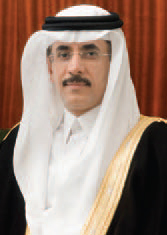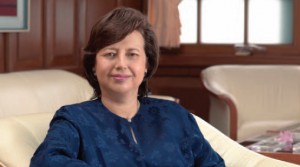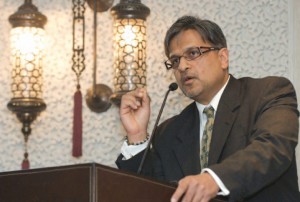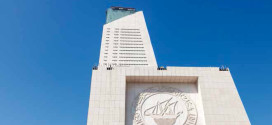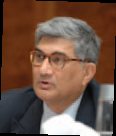
The doom and gloom precipitated in 2008 by the global financial crisis and more recently by the eurozone sovereign debt crisis will continue unabated through 2012, and the impact on the global markets will equally not be spared. MUSTAK PARKER reports
The MENA region with its home-made so-called Arab Spring revolution, albeit confined to Egypt, Tunisia, Libya and Yemen for the moment, and potentially extending to Syria, Iran, Morocco, Algeria and Bahrain, is faced with its own unique challenges, including political governance and stability; economic policies to generate growth and jobs, especially youth employment; the rule of law; and attracting increased foreign direct investment (FDI) flows.
This is the general consensus among government officials, multilaterals, banks and corporates that are familiar with the region. The outlook is mixed depending on the particular country, market and individual. But there are signs that the Islamic finance industry is in a better position to capitalise on potential opportunities in fund raising through Sukuk; increasing and improving trade finance facilities and terms to boost intra-Islamic trade; and to contribute to employment generation initiatives especially for the youth through microfinance.
“Of course the member countries of the Islamic Development Bank (IDB) are affected by the eurozone sovereign debt crisis, because the region is a major trading partner of some of our member countries such as Turkey and the North African Mediterranean states. They have been hit by lower exports to the EU, which in turn has affected their trade and current account balances,” explained Dr Ahmed Mohamed Ali, president of the IDB.
Indeed, the IDB board of executive directors in April 2011 approved a $250m fund to finance employment generation and small businesses in the Arab Spring countries undergoing political and economic transformation. Much of this financing will be disbursed to SMEs and through microfinance facilities.
“This fund is being financed through our ordinary resources. We are starting to disburse these funds in investments very imminently,” confirmed Dr Ali. This funding, he added, will enhance building institutional capacity of those countries either by supporting training programmes that meet labour market needs, or by supporting microfinance institutions, vocational training, and lines of financing for SMEs.
Financing trade, SMEs and creating jobs is also a major priority for the Jeddah-based Islamic Corporation for the Development of the Private Sector (ICD), the private sector funding arm of the IDB Group. ICD chief executive officer Khaled Al-Aboodi confirmed that the corporation is “very aware of the impact assessment of the projects we are involved in especially in generating growth and jobs. As part of our new strategy, we have set up a new department within ICD to look into these issues, including evaluating the performance of our projects in contributing to job creation. There has been a lot of talk about the growth model of the World Bank/IMF, which helped some countries to achieve double-digit growth but where the impact was not felt at the level of ordinary people. We are looking at a growth model where we can be satisfied that our financing has an economic impact on ordinary people”.
The IDB board of executive directors in December 2012 approved a SR1bn Saudi SME Investment Fund, which will be managed by ICD and in which the IDB itself is committing an initial $53m. The aim is for ICD to fund SMEs directly as opposed to giving lines of credit to banks, which would then extend financing to SMEs.
“We are also using our Ijara (leasing) companies to facilitate financing directly to the SMEs and through the creation of SME investment funds. We are establishing the first SME Investment Fund in Saudi Arabia which will be a SR1bn Shariah-compliant SME fund, which will be the first of its kind. We will be financing companies that are not big enough to progress on their own. It is our first test and we will take this concept to other member countries later. It will involve a lot of technical assistance in terms of business processes, financial reporting, ownership structures etc. The goal is once the companies are restructured and on a sound footing, ICD will exit the investment. We want to leave a sound company that would be able to attract future lines of financing from ICD or local banks,” explained ICD’s Al-Aboodi.
Jalloul Ayed, the Minister of Finance of one IDB member country, Tunisia, speaking at the launch of the 2011 World Investment and Political Risk report published by the World Bank’s Multilateral Investment Guarantee Agency (MIGA) in London in December 2011 warned that his country cannot transform on its own and needs the financial, economic and investment support from outside.
“We cannot do it on our own. If we do not create jobs especially for the youth, we will be answerable to the people at the next election. The first phase of transition to democracy was a very important first step, perhaps even a giant leap in the history of the country. The challenge now is to navigate this transition to consolidating our democracy and economy,” he explained.
This is best done, it was felt, through strong and legitimate government; through the rule of law complete with the reform of the judiciary and separation of powers; the development of civil society with strong institutions and administration and of political culture; and the building of a strong economy and institutions with a role for government and the private sector.
Another indicator of the tough times ahead in 2012 for the global economy is the much increased demand for commercial and credit risk, political risk and sovereign risk insurance. In the MENA countries, demand for Shariah-compliant PRI has increased significantly as managing global and regional political risks becomes a major challenge for investors and financiers alike.
Ravi Vish, director and chief economist of the World Bank’s Multilateral Investment Guarantee Agency (MIGA), confirmed that demand for political risk insurance (PRI) has increased to unprecedented levels, with PRI supply by members of the Berne Union remaining robust and pricing reflecting a buyers’ market. MIGA cooperates closely with the Islamic Corporation for the Insurance of Investment and Export Credit (ICIEC), the standalone Export Credit Agency (ECA) of the IDB Group.
MIGA and ICIEC are the only two multilaterals that are members of the Berne Union, a grouping of state-owned Export Credit Agencies (ECAs), private ECAs and multilaterals from around the world. ICIEC has co-underwritten PRI with MIGA in several MENA countries to insure their investments against the risk of war, civil disturbances, expropriation, transfer restrictions, and non-honoring of sovereign financial obligations of the host country.
It seems that ICIEC has pre-empted MIGA’s Ravi Vish’s contention that PRI providers will have to be nimble, flexible and better informed about their potential markets and clients in securing new underwriting business. The corporation in fact launched a pioneering “Non-honoring of Sovereign Financial Obligations (NHSFO) Insurance” in 2010 well before the onset of the Arab Spring protests. The NHSFO protects investors and financiers against the risk of the sovereign host country not complying with the demand to pay under an unconditional and irrevocable financial guarantee. According to ICIEC, the corporation started with issuing two policies – one direct insurance and one reinsurance – and is now processing on several policy applications that will be issued in due course.
The political transformation in the MENA region, confirmed Dr Abdel Rahman El-Tayeb Taha, the chief executive officer of ICIEC, will present new opportunities. While he feels that the economic fundamentals of the MENA region are sound, and maintains that the corporation is ready to take calculated risks in countries where the political crisis is contained, MIGA’s Ravi Vish warns that the short-term outlook for global foreign direct investment (FDI) flows is bleak, although in the medium-term, FDI flows will get better but it is difficult to quantify by how much.
As far as the Arab Spring countries are concerned, new investors are adopting a wait-and-see attitude which might persist for a year or so, to see how the transition to democracy pans out in countries such as Egypt, Tunisia and Libya. This is also manifested in the ratings for political risk. Bahrain, according to MIGA, is seeing weaker drift, which means it requires higher PRI cover; Qatar and the UAE both have higher ratings; while Tunisia has hardly moved, perhaps even slipping slightly.
A survey by MIGA-EIU in 2011 revealed that the turmoil in the Arab countries did have a significant impact on investor intentions. According to the survey findings, investors in the MENA region did not anticipate what had happened and were caught by surprise. Violence, the absence of the rule of law and government instability are major factors that put off potential investors. MIGA emphasises that it has learnt from the Arab Spring experience and is in the process of revising its risk assessment strategies to incorporate some of the findings of the survey especially the impact of rising food and commodity prices on family income and the absence of democratic governance.
World Bank forecasts show that foreign direct investment (FDI) flows into the MENA region will decline in 2011 and 2012, with a slight rally in 2013. For the period 2000-10, according to the World Bank, the Arab Spring countries of Egypt, Tunisia and Libya attracted $55bn, $18bn and $20bn of FDI respectively. Saudi Arabia was by far the largest recipient of cumulative FDI flows totalling just under $150bn, followed by the UAE with just under US$80bn, Qatar with $31bn and Lebanon with $29bn.
Prospects in the Arab Spring countries according to MIGA “will depend on the speed of resolving the political situation, since investment takes longer to recover than economic growth. With Europe under economic strain and uncertainties surrounding the political environment of Egypt, Libya and Tunisia, FDI flows into North Africa are likely to slump for longer and rebound more slowly than the rest of the MENA region”.
The Islamic finance industry, however, offers much greater hope for the MENA region judging by the imminent launch of several important initiatives and spearheaded by the IDB, the multilateral development bank of the Muslim world, and the International Islamic Liquidity Management Corporation (IILM), the pan-Islamic institution that started operations in February 2011 and whose mandate is to provide cross-border international liquidity management to the global Islamic finance industry.
IDB president Dr Ali gave some valuable insight into the bank’s resource mobilisation strategy to fund its extensive trade and development finance requirements in 2012 and beyond. The bank is under pressure to leverage its AAA rating by the Big Three international rating agencies – Standard & Poor’s, Moody’s and Fitch – to raise funds from the financial markets, in addition to equity and callable capital. “We will start soon with our new strategy. We had our Board meeting in December 2011. We want to be every year in the market. It is important for the bank to raise funds from the market. In the past we did not give enough attention to this. We will finish our current $3.5bn Islamic Trust Certificates Programme and then go to market every year with a Sukuk offering. The size will depend on market conditions and pricing. Our board is putting pressure on us to raise money from the capital markets rather than finance activities through capital and equity. We need to do both,” he maintained.
Dr Ali confirmed that the IDB will definitely embark on a new Sukuk programme. However, it was too premature to say what the size would be, although it is most likely to be in the same region as the last one.
The current IDB Islamic Trust Certificates Programme totals $3.5bn. The IDB has thus far issued a $400m debut Sukuk; followed by a $500m Sukuk and an $850m Sukuk in 2009; a $500m Sukuk in 2010 and the recent $750m in May 2011, thus bringing the total volume of IDB Sukuk offerings to date to US$3bn – the largest volume of Sukuk issuances by any supranational. This leaves $500m of issuances to come.
There is also good news on two other fronts. The bank is reviewing its strategy and capacity to meet the target set by its board to achieve an intra-Islamic trade target of 20 per cent by the year 2015. Currently, the figure is 17 per cent. The target, maintains Dr Ali, is achievable and sustainable “if we work harder”. He believes the bank has enough resources to achieve the target.
According to IDB figures, the cumulative net approvals for 19 MENA member countries of the multilateral development bank of the Muslim World at the end of August 2011 totalled $39.5bn, which is about 52 per cent of the total approvals of the bank since it started operations in 1976. Total gross approvals of the IDB to date amounted to $78,854.6m. Total trade finance operations approved by the IDB to date, has reached $36,959.3m. But put this against the total trade of the 56 IDB member countries of $3.374 trillion in 2009, then the sheer scale of the challenge faced by the IDB as a group becomes apparent. In the first nine months of 2011, IDB Group approvals for the MENA region amounted to $2.4bn.
The IDB Group has in the past been criticised that its terms of financing trade, especially commodity Murabaha and Instalment Sale facilities, is perceived by the market to be less competitive and flexible compared with the general banking sector.
Dr Ali agrees that the terms of trade of IDB Group financing are not competitive or flexible when compared with the private sector. “This is true but we are doing our very best to be more competitive. We can close the gap. One of the reasons is that IDB raises financing from the market at a price that is more expensive.”
The IDB is under further pressure by its new board, which in December 2011 considered preliminary projections for the bank’s financings for three years, five years and 10 years. “This will give us an idea of how the growth demand will take place. In the aftermath of the financial crisis, the IDB board decided on a 30 per cent increase per annum in our financing for the next three years. We have found that this target is very ambitious and high. Our board reiterated at its meeting in Jeddah in December that the bank cannot revise this figure downwards and must continue with this target,” he explained.
Another major market mover in 2012 could be IILM, which expects its debut Sukuk to be issued in the first half of 2012.
“It has been a long process to get the rating and high quality underlying assets, and to obtain all the parameters for the issuance. The first issuance will be a relatively smaller issuance to test the system and to ensure that it is working. It will be a pilot issuance. Subsequent regular issuances will be larger, in the range of $2bn to $3bn per issue under a programme. The issuances will be in major currencies,” confirmed Dr Zeti Akhtar Aziz, Governor of Bank Negara Malaysia, the central bank, and a member of the IILM governing board.
IILM is poised to issue high quality, short-term liquid instruments that will probably be in demand from other institutions as well as managing portfolios, pensions etc because they are an asset class that would be attractive as a liquid instrument.
The Sukuk will be issued by corporations that are established by the shareholders of the IILM, which are 10 central banks and two multilaterals, namely the Islamic Development Bank (IDB) and the Islamic Corporation for the Development of the Private Sector (ICD).
“In conventional finance, it is the US Treasury that issues Treasury bills, which the whole world buys. These are highly traded. For Islamic finance there are no sovereign short-term debt issuances or papers of that nature,” said Dr Zeti.
One other important development that has the potential to boost the alternative nature of Islamic finance is the Islamic Interbank Benchmark Rate (IIBR), a Shariah-compliant alternative to LIBOR (the London Inter Bank Offered Rate), which was launched in November 2011 by Thomson Reuters in Bahrain
The new benchmark, says Thomson Reuters, can be used to price a number of Islamic instruments, including common overnight to short-term treasury investment and financing instruments such as Murabaha, Wakala and Mudaraba, retail financing instruments such as property and car finance, and Sukuk and other Shariah-compliant fixed income instruments. It can also be used for the pricing and benchmarking of corporate finance and investment assets.
According to Rushdi Siddiqui, global head of Islamic finance, Thomson Reuters, the IIBR is designed to provide an
objective and dedicated indicator for the average expected return on Shariah-compliant short-term interbank funding. IIBR uses the contributed rates of 16 Islamic banks and the Islamic sections of conventional banks (many from the GCC countries) “to provide a reliable and much-needed alternative for pricing Islamic instruments to the conventional interest-based benchmarks used for mainstream banking sector”.
The benchmark’s ongoing implementation and integrity will be overseen by an Islamic Benchmark Committee of more than 20 Islamic finance institutions, chaired by Dr Nasser Saidi, chief economist of the Dubai International Financial Centre (DIFC).
Dr Saidi maintains that “the establishment of the IIBR marks an important milestone in the maturation of Islamic money markets by providing an international reference rate for interbank transactions. Conventional money markets have relied on LIBOR, which, by definition, does not comply with Shariah conventions. Islamic markets will be able to rely on the IIBR and it will become an international reference rate for both conventional and Sharia-compliant transactions. Our aim is to provide an IIBR that is reliable, timely, representative of market conditions, transparent in its construction and accepted as the market reference. Islamic money and financial markets are coming of age and becoming part of the mainstream.”
Others such as UK law firm Simmons & Simmons, emphasise that the success of the IIBR will depend on its take up by the Islamic finance industry, although the participation of the large number of well known Islamic banks is encouraging.
“Experience has shown that most customers (whether retail or corporate) of Islamic finance are comfortable with LIBOR and similar rates, and will inevitably make price comparisons between LIBOR and IIBR. To the extent that IIBR exceeds LIBOR, customers may well prefer LIBOR as the pricing benchmark for their financing instruments and IIBR for their deposit instruments, irrespective of the Shariah compliant nature of IIBR,” explained Muneer Khan, head of Islamic finance at Simmons & Simmons.
 Cash And Trade Magazine For Cash and Trade professionals in the Middle East
Cash And Trade Magazine For Cash and Trade professionals in the Middle East


